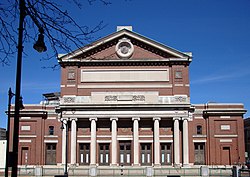Symphony Hall, Boston

Symphony Hall from the south.
|
|
| Address | 301 Massachusetts Avenue |
|---|---|
| Location | Boston, Massachusetts |
| Coordinates | 42°20′33.34″N 71°5′8.9″W / 42.3425944°N 71.085806°WCoordinates: 42°20′33.34″N 71°5′8.9″W / 42.3425944°N 71.085806°W |
| Public transit | Symphony |
| Owner | Boston Symphony Orchestra |
| Type | concert hall |
| Construction | |
| Built | 1900 |
| Website | |
| www |
|
|
Symphony Hall
|
|
| Architect | McKim, Mead and White |
| Architectural style | Renaissance |
| NRHP Reference # | 99000633 |
| Significant dates | |
| Added to NRHP | January 20, 1999 |
| Designated NHL | January 20, 1999 |
Symphony Hall is a concert hall located at 301 Massachusetts Avenue in Boston, Massachusetts. Designed by McKim, Mead and White, it was built in 1900 for the Boston Symphony Orchestra, which continues to make the hall its home. The hall was designated a U.S. National Historic Landmark in 1999 and is a pending Boston Landmark. It was then noted that "Symphony Hall remains, acoustically, among the top three concert halls in the world ... and is considered the finest in the United States." Symphony Hall, located one block from Berklee College of Music to the north and one block from the New England Conservatory to the south, also serves as home to the Boston Pops Orchestra as well as the site of many concerts of the Handel and Haydn Society.
Symphony Hall was inaugurated on October 15, 1900, after the Orchestra's original home (the Old Boston Music Hall) was threatened by road-building and subway construction. Architects McKim, Mead and White engaged Wallace Clement Sabine, a young assistant professor of physics at Harvard University, as their acoustical consultant, and Symphony Hall became one of the first auditoria designed in accordance with scientifically derived acoustical principles. Admired for its lively acoustics from the time of its opening, the hall is often cited as one of the best sounding classical concert venues in the world.
The hall is modeled on the second Gewandhaus concert hall in Leipzig, which was later destroyed in World War II. The Hall is relatively long, narrow, and high, in a rectangular "shoebox" shape like Amsterdam's Concertgebouw and Vienna's Musikverein. It is 18.6m high, 22.9m wide, and 38.1m long from the lower back wall to the front of the stage. Stage walls slope inward to help focus the sound. With the exception of its wooden floors, the Hall is built of brick, steel, and plaster, with modest decoration. Side balconies are very shallow to avoid trapping or muffling sound, and the coffered ceiling and statue-filled niches along three sides help provide excellent acoustics to essentially every seat. Conductor Herbert von Karajan, in comparing it to the Musikverein, stated that "for much music, it is even better... because of its slightly lower reverberation time."
...
Wikipedia
